2017 HYUNDAI TUCSON LIMITED sae
[x] Cancel search: saePage 21 of 642
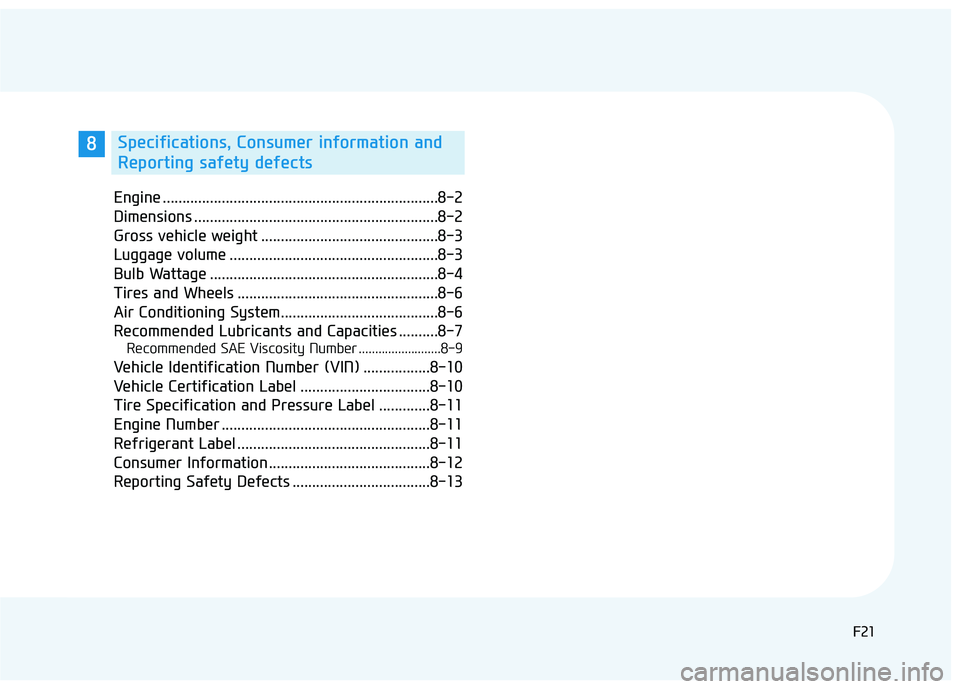
F21F21
Engine ......................................................................8-2
Dimensions ..............................................................8-2
Gross vehicle weight .............................................8-3
Luggage volume .....................................................8-3
Bulb Wattage ..........................................................8-4
Tires and Wheels ...................................................8-6
Air Conditioning System........................................8-6
Recommended Lubricants and Capacities ..........8-7
Recommended SAE Viscosity Number .........................8-9
Vehicle Identification Number (VIN) .................8-10
Vehicle Certification Label .................................8-10
Tire Specification and Pressure Label .............8-11
Engine Number .....................................................8-11
Refrigerant Label .................................................8-11
Consumer Information .........................................8-12
Reporting Safety Defects ...................................8-13
8Specifications, Consumer information and
Reporting safety defects
Page 471 of 642
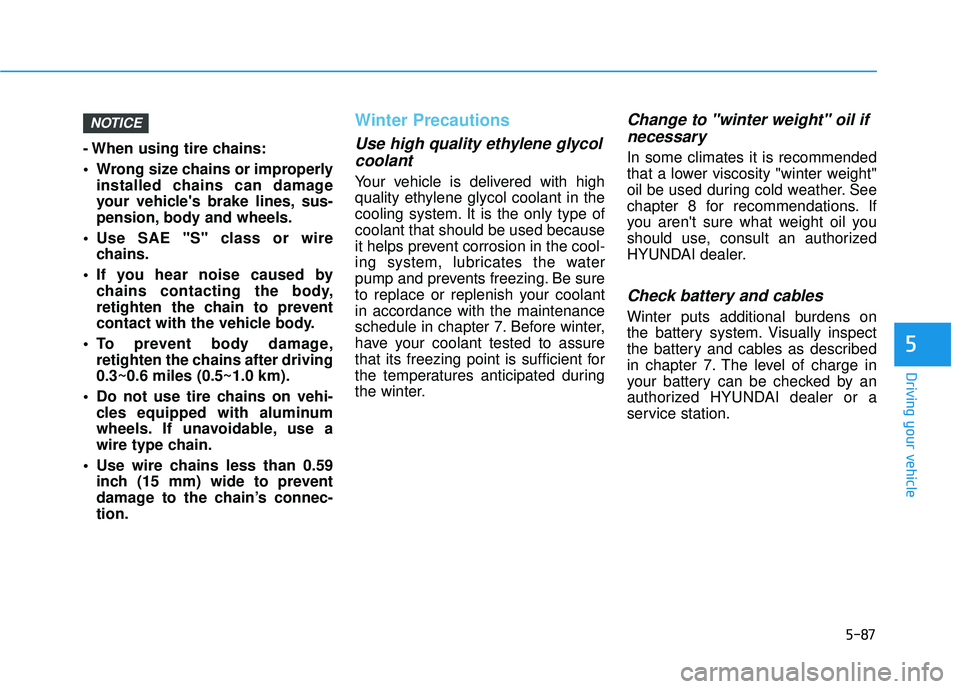
5-87
Driving your vehicle
5
- When using tire chains:
Wrong size chains or improperlyinstalled chains can damage
your vehicle's brake lines, sus-
pension, body and wheels.
Use SAE "S" class or wire chains.
If you hear noise caused by chains contacting the body,
retighten the chain to prevent
contact with the vehicle body.
To prevent body damage, retighten the chains after driving0.3~0.6 miles (0.5~1.0 km).
Do not use tire chains on vehi- cles equipped with aluminum
wheels. If unavoidable, use a
wire type chain.
Use wire chains less than 0.59 inch (15 mm) wide to prevent
damage to the chain’s connec-tion.
Winter Precautions
Use high quality ethylene glycol
coolant
Your vehicle is delivered with high
quality ethylene glycol coolant in the
cooling system. It is the only type ofcoolant that should be used because
it helps prevent corrosion in the cool-
ing system, lubricates the water
pump and prevents freezing. Be sure
to replace or replenish your coolantin accordance with the maintenance
schedule in chapter 7. Before winter,
have your coolant tested to assure
that its freezing point is sufficient for
the temperatures anticipated during
the winter.
Change to "winter weight" oil if
necessary
In some climates it is recommended
that a lower viscosity "winter weight"
oil be used during cold weather. See
chapter 8 for recommendations. If
you aren't sure what weight oil you
should use, consult an authorized
HYUNDAI dealer.
Check battery and cables
Winter puts additional burdens on
the battery system. Visually inspect
the battery and cables as described
in chapter 7. The level of charge in
your battery can be checked by an
authorized HYUNDAI dealer or a
service station.
NOTICE
Page 619 of 642
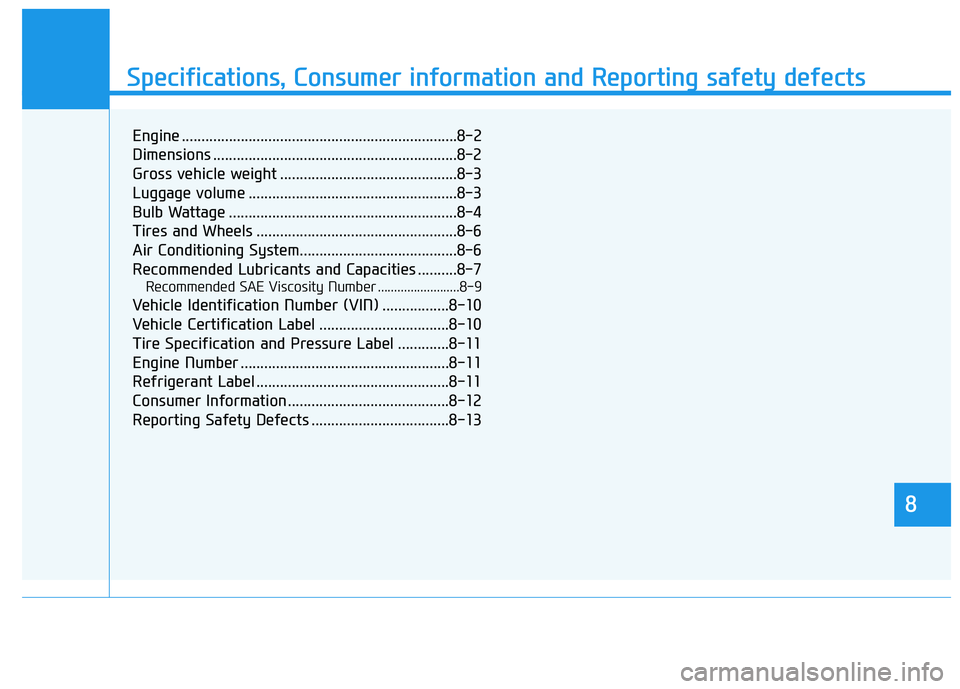
Specifications, Consumer information and Reporting safety defects
8
Engine ......................................................................8-2
Dimensions ..............................................................8-2
Gross vehicle weight .............................................8-3
Luggage volume .....................................................8-3
Bulb Wattage ..........................................................8-4
Tires and Wheels ...................................................8-6
Air Conditioning System........................................8-6
Recommended Lubricants and Capacities ..........8-7
Recommended SAE Viscosity Number .........................8-9
Vehicle Identification Number (VIN) .................8-10
Vehicle Certification Label .................................8-10
Tire Specification and Pressure Label .............8-11
Engine Number .....................................................8-11
Refrigerant Label .................................................8-11
Consumer Information .........................................8-12
Reporting Safety Defects ...................................8-13
Page 621 of 642
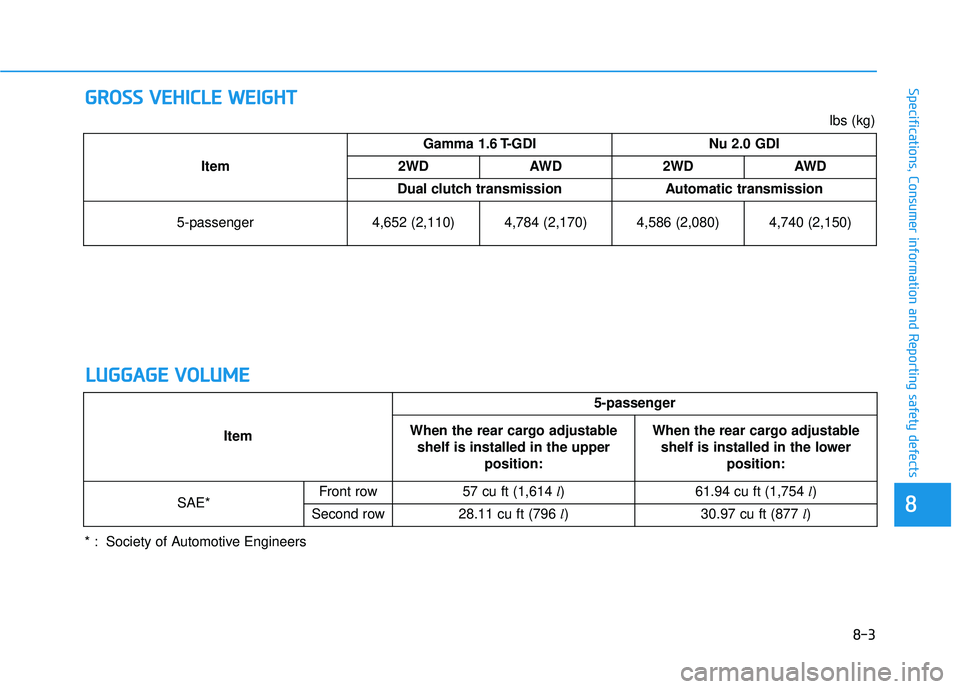
GGRROO SSSS VV EEHH IICC LLEE WW EEIIGG HH TT
8-3
88
Specifications, Consumer information and Reporting safety defects
LLUU GGGGAAGG EE VV OO LLUU MM EE
Item Gamma 1.6 T-GDI Nu 2.0 GDI
2WD AWD 2WD AWD
Dual clutch transmissionAutomatic transmission
5-passenger 4,652 (2,110) 4,784 (2,170) 4,586 (2,080) 4,740 (2,150)
Item 5-passenger
When the rear cargo adjustable shelf is installed in the upper position: When the rear cargo adjustable
shelf is installed in the lower position:
SAE* Front row
57 cu ft (1,614
l) 61.94 cu ft (1,754 l)
Second row 28.11 cu ft (796
l) 30.97 cu ft (877 l)
lbs (kg)
* : Society of Automotive Engineers
Page 625 of 642
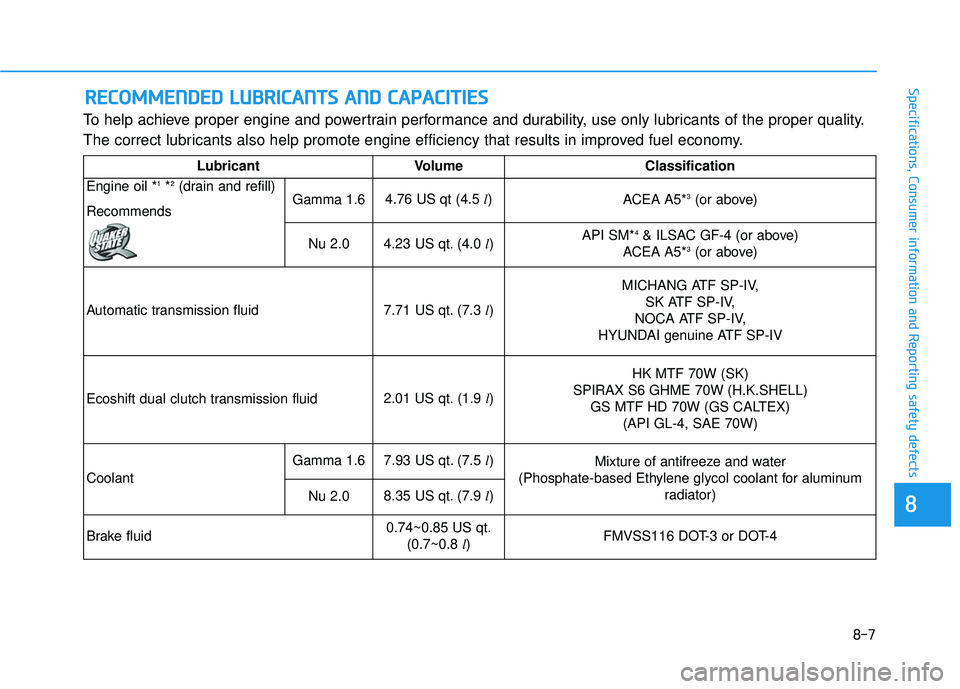
8-7
88
Specifications, Consumer information and Reporting safety defects
To help achieve proper engine and powertrain performance and durability, use only lubricants of the proper quality.
The correct lubricants also help promote engine efficiency that results in improved fuel economy.
RREECCOO MM MMEENN DDEEDD LL UU BBRRIICC AA NN TTSS AA NN DD CC AA PPAA CCIITT IIEE SS
Lubricant Volume Classification
Engine oil * 1
*2
(drain and refill)
Recommends Gamma 1.6
4.76 US qt (4.5
l)
ACEA A5*3
(or above)
Nu 2.0 4.23 US qt. (4.0
l) API SM*
4
& ILSAC GF-4 (or above)
ACEA A5* 3
(or above)
Automatic transmission fluid 7.71 US qt. (7.3
l) MICHANG ATF SP-IV,
SK ATF SP-IV,
NOCA ATF SP-IV,
HYUNDAI genuine ATF SP-IV
Ecoshift dual clutch transmission fluid 2.01 US qt. (1.9
l) HK MTF 70W (SK)
SPIRAX S6 GHME 70W (H.K.SHELL) GS MTF HD 70W (GS CALTEX) (API GL-4, SAE 70W)
Coolant Gamma 1.6
7.93 US qt. (7.5
l)
Mixture of antifreeze and water
(Phosphate-based Ethylene glycol coolant for aluminum radiator)
Nu 2.08.35 US qt. (7.9 l)
Brake fluid 0.74~0.85 US qt.
(0.7~0.8 l) FMVSS116 DOT-3 or DOT-4
Page 626 of 642
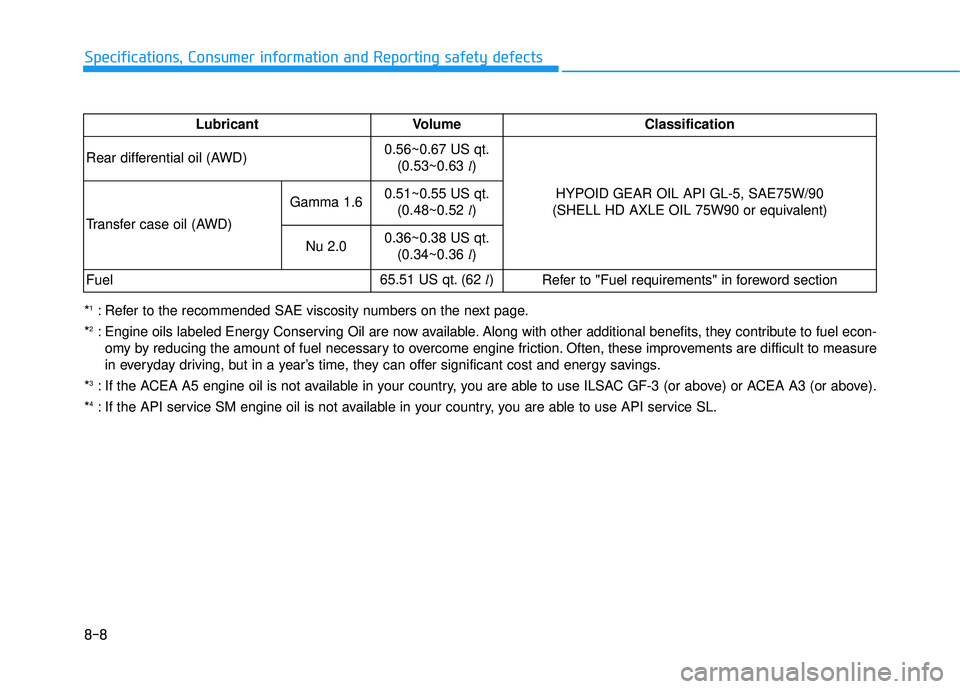
8-8
Specifications, Consumer information and Reporting safety defects
*1
: Refer to the recommended SAE viscosity numbers on the next page.
* 2
: Engine oils labeled Energy Conserving Oil are now available. Along with other additional benefits, they contribute to fuel econ -
omy by reducing the amount of fuel necessary to overcome engine friction. Often, these improvements are difficult to measure
in everyday driving, but in a year’s time, they can offer significant cost and energy savings.
* 3
: If the ACEA A5 engine oil is not available in your country, you are able to use ILSAC GF-3 (or above) or ACEA A3 (or above).
* 4
: If the API service SM engine oil is not available in your country, you are able to use API service SL. Lubricant Volume Classification
Rear differential oil (AWD) 0.56~0.67 US qt.
(0.53~0.63 l)
HYPOID GEAR OIL API GL-5, SAE75W/90
(SHELL HD AXLE OIL 75W90 or equivalent)
Transfer case oil (AWD) Gamma 1.6
0.51~0.55 US qt.
(0.48~0.52 l)
Nu 2.0 0.36~0.38 US qt.
(0.34~0.36 l)
Fuel 65.51 US qt. (62
l)
Refer to "Fuel requirements" in foreword section
Page 627 of 642
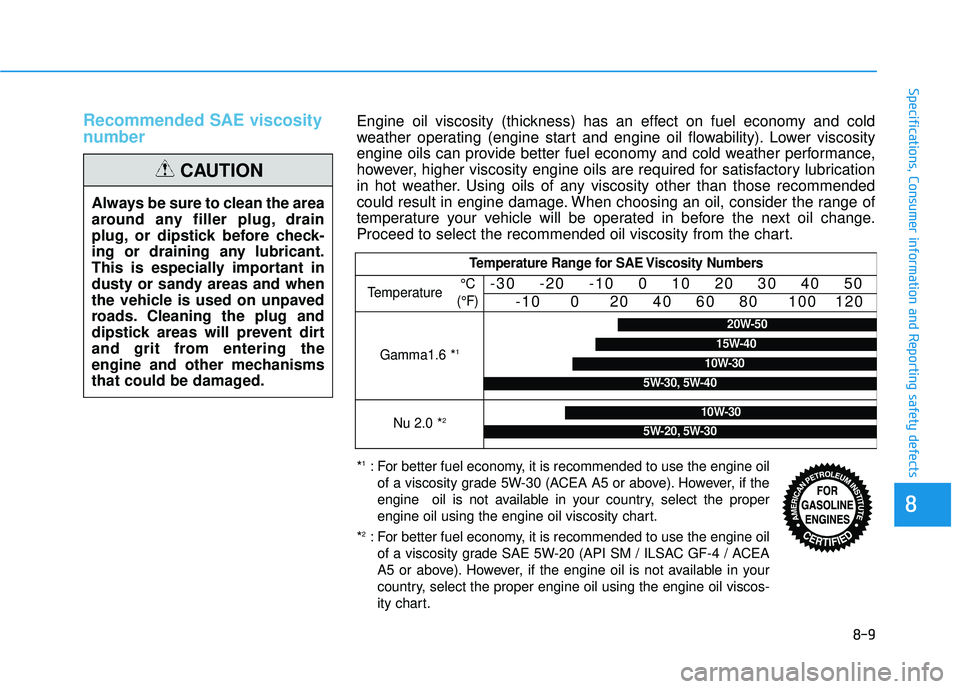
8-9
88
Specifications, Consumer information and Reporting safety defects
Recommended SAE viscosity
number
Always be sure to clean the area
around any filler plug, drain
plug, or dipstick before check-
ing or draining any lubricant.
This is especially important in
dusty or sandy areas and when
the vehicle is used on unpaved
roads. Cleaning the plug and
dipstick areas will prevent dirt
and grit from entering the
engine and other mechanisms
that could be damaged.
CAUTION
Engine oil viscosity (thickness) has an effect on fuel economy and cold
weather operating (engine start and engine oil flowability). Lower viscosity
engine oils can provide better fuel economy and cold weather performance,
however, higher viscosity engine oils are required for satisfactory lubrication
in hot weather. Using oils of any viscosity other than those recommended
could result in engine damage. When choosing an oil, consider the range of
temperature your vehicle will be operated in before the next oil change.
Proceed to select the recommended oil viscosity from the chart.
Temperature Range for SAE Viscosity Numbers
Temperature -30 -20 -10 0 10 20 30 40 50
-10 0 20 40 60 80 100 120
Gamma1.6 *1
Nu 2.0 *210W-30
5W-20, 5W-30
°C
(°F)
5W-30, 5W-40
10W-30
15W-40
20W-50
* 1
: For better fuel economy, it is recommended to use the engine oil
of a viscosity grade 5W-30 (ACEA A5 or above). However, if the
engine oil is not available in your country, select the proper
engine oil using the engine oil viscosity chart.
* 2
: For better fuel economy, it is recommended to use the engine oil
of a viscosity grade SAE 5W-20 (API SM / ILSAC GF-4 / ACEA
A5 or above). However, if the engine oil is not available in your
country, select the proper engine oil using the engine oil viscos-
ity chart.
Page 640 of 642
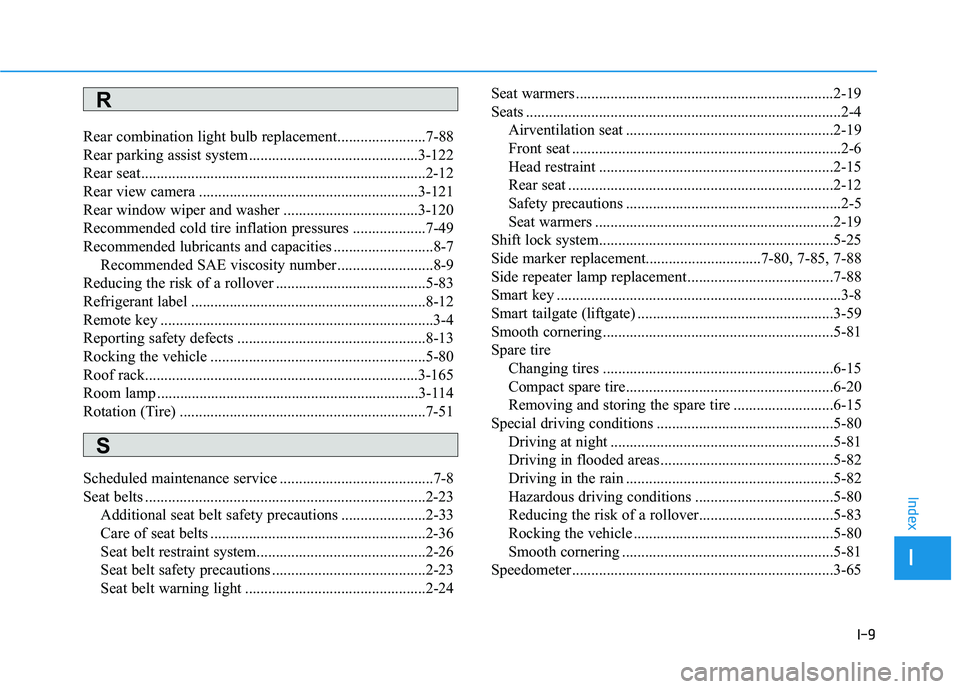
I-9
Rear combination light bulb replacement.......................7-88
Rear parking assist system............................................3-122
Rear seat..........................................................................2-12
Rear view camera .........................................................3-121
Rear window wiper and washer ...................................3-120
Recommended cold tire inflation pressures ...................7-49
Recommended lubricants and capacities ..........................8-7Recommended SAE viscosity number .........................8-9
Reducing the risk of a rollover .......................................5-83
Refrigerant label .............................................................8-12
Remote key .......................................................................3-4
Reporting safety defects .................................................8-13
Rocking the vehicle ........................................................5-80
Roof rack.......................................................................3-165
Room lamp ....................................................................3-114
Rotation (Tire) ................................................................7-51
Scheduled maintenance service ........................................7-8
Seat belts .........................................................................2-23
Additional seat belt safety precautions ......................2-33
Care of seat belts ........................................................2-36
Seat belt restraint system............................................2-26
Seat belt safety precautions ........................................2-23
Seat belt warning light ...............................................2-24 Seat warmers ...................................................................2-19
Seats ..................................................................................2-4
Airventilation seat ......................................................2-19
Front seat ......................................................................2-6
Head restraint .............................................................2-15
Rear seat .....................................................................2-12
Safety precautions ........................................................2-5
Seat warmers ..............................................................2-19
Shift lock system.............................................................5-25
Side marker replacement..............................7-80, 7-85, 7-88
Side repeater lamp replacement ......................................7-88
Smart key ..........................................................................3-8
Smart tailgate (liftgate) ...................................................3-59
Smooth cornering............................................................5-81
Spare tire Changing tires ............................................................6-15
Compact spare tire......................................................6-20
Removing and storing the spare tire ..........................6-15
Special driving conditions ..............................................5-80
Driving at night ..........................................................5-81
Driving in flooded areas .............................................5-82
Driving in the rain ......................................................5-82
Hazardous driving conditions ....................................5-80
Reducing the risk of a rollover...................................5-83
Rocking the vehicle ....................................................5-80
Smooth cornering .......................................................5-81
Speedometer....................................................................3-65
I
Index
R
S